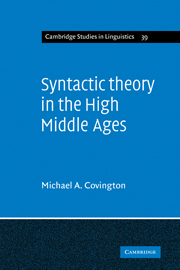Book contents
- Frontmatter
- Contents
- SOLI DEO GLORIA
- Preface
- 1 Introduction
- 2 Before the Modistae
- 3 Modistic grammar
- 4 Syntactic structure
- 5 Modistic treatments of particular syntactic problems
- 6 Subsequent developments
- Appendix: Notes on certain questions of authorship
- Notes
- Bibliography
- Index of names
- Index of topics
- Index of Greek terms
4 - Syntactic structure
Published online by Cambridge University Press: 04 August 2010
- Frontmatter
- Contents
- SOLI DEO GLORIA
- Preface
- 1 Introduction
- 2 Before the Modistae
- 3 Modistic grammar
- 4 Syntactic structure
- 5 Modistic treatments of particular syntactic problems
- 6 Subsequent developments
- Appendix: Notes on certain questions of authorship
- Notes
- Bibliography
- Index of names
- Index of topics
- Index of Greek terms
Summary
The great achievement of the Modistae with regard to syntactic theory was the development of a formal model of sentence structure. In the fully developed modistic model, the sentence was analyzed into a set of ‘constructions,’ or linkages connecting one word with another, and each construction was then described in terms of the two primitive grammatical relations, that of dependens to terminans and that of primurn to secundum. The emergence of this model marked the culmination of the move toward formally explicit, conceptually parsimonious syntactic descriptions that had been going on since the early days of regimen-theory.
In many ways the syntactic theory of the Modistae reflects the Aristotelian philosophical paradigm within which they worked; medieval philosophers regularly drew on the ontology and metaphysics of Aristotle for the kind of tools of thought that modern linguists draw from set theory and related disciplines. For example, the one-to-one relationship of dependens to terminans in each construction lent itself well to treatment in terms of Aristotelian dichotomies such as matter-form and actual-potential, and it may be that this fact helped promote the idea that all constructions should in fact be viewed as one-to-one relationships.
However, it would be a mistake to think of modistic grammar as a force-fit of linguistic structure onto Aristotelian metaphysics. The Modistae, being realists, held that the perceptible world had a definite structure and that the semantic function of language was to represent this structure; hence they used Aristotelian ontology as a theory of the things language could signify, and as such it figured prominently in their semantics.
- Type
- Chapter
- Information
- Syntactic Theory in the High Middle AgesModistic Models of Sentence Structure, pp. 41 - 82Publisher: Cambridge University PressPrint publication year: 1984



